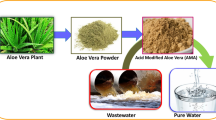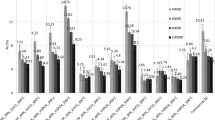Abstract
In the present work, physically and chemically activated carbons are prepared using Sal wood (Shorea robusta) sawdust by thermal process and using sulfuric acid as the activation agent to remove Pb(II) from aqueous solutions. Adsorption equilibrium studies have been done at a pH of 4 and a room temperature of 30 °C. It was found that the adsorption isotherms are favorable and chemically activated carbons are better than physically activated carbon in terms of adsorption capacity. Various two-parameter adsorption isotherm models, viz. Freundlich, Langmuir, Temkin and Dubinin-Radushkevich, were used to fit the equilibrium data and it was found that the Freundlich adsorption model provided best-fit. The first-order irreversible unimolecular reaction model and the pseudo-second-order kinetic models were used to fit the kinetic data and it was found that both the models provided good fit. Kinetic and film diffusion studies show that the adsorption of lead(II) on the activated carbons tested in this work are both intra-particle and film diffusion controlled.
Zusammenfassung
In dieser Arbeit wird physikalisch und chemisch aktivierter Kohlenstoff aus Salholzsägemehl mittels eines thermischen Verfahrens und unter Verwendung von Schwefelsäure als Aktivierungsmittel hergestellt, um Pb(II) aus wässrigen Lösungen zu entfernen. Untersucht wurde das Adsorptionsgleichgewicht bei einem pH-Wert von 4 und einer Raumtemperatur von 30 °C. Adsorptionsisothermen zeigten gute Ergebnisse. In Bezug auf die Adsorptionskapazität erwies sich dabei chemisch aktivierter Kohlenstoff besser als physikalisch aktivierter Kohlenstoff. Zweiparametrige Modelle zur Beschreibung der Adsorptionsisothermen nach Freundlich, Langmuir, Temkin und Dubinin-Radushkevich wurden an die Versuchsdaten angepasst. Dabei erwies sich das Adsorptionsmodell von Freundlich als am besten geeignet. Die kinetischen Daten wurden an das irreversible unimolekulare Reaktionsmodell erster Ordnung und die kinetischen Modelle pseudo-zweiter Ordnung angepasst. Beide Modelle lieferten gute Ergebnisse. Kinetische und Filmdiffusionsstudien zeigten dass die Adsorption von Pb(II) an die Aktivkohle sowohl durch Intrapartikel- als auch durch Filmdiffusionsprozesse gesteuert wird.
Similar content being viewed by others
References
Abdel-Halim SH, Shehata AMA, El-Shahat MF (2003) Removal of lead ions from industrial waste water by different types of natural materials. Water Res 37:1678–1683
BIS (1989) Activated carbons, Powdered and Granular – Methods of sampling and test, Bureau of Indian Standards, IS 877:1989
Boyd GE, Adamson AW, Myers Jr LS (1947) The exchange adsorption of ions from aqueous solutions by organic zeolites. II. Kinetics. J Am Chem Soc 69:2836–2848
Dubinin MM (1960) The potential theory of adsorption of gases and vapors for adsorbents with energetically non-uniform surface. Chem Rev 60:235–266
EHC (1977) Environmental Health Criteria -3 (1977): Lead, World Health Organization, Geneva
Faur-Brasquet C, Reddad Z, Kadirvelu K, Le Cloirec P (2002) Modeling the adsorption of metal ions (Cu, Ni,Pb) onto ACCs using surface complexation models. Appl Surf Sci 196:356–365
Freundlich HMF (1906) Über die Adsorption in Lösungen. Z Physik Chemie (Leipzig) 57A:385–470
Gharajbeh SH, Abu-el-sha’r WY, Al-kofani MM (1998) Removal of selected heavy metals from aqueous solutions using processed solid residue of olive mill products. Water Res 32:498–502
Goel J, Kadirvelu K, Rajagopal C, Garg VK (2005) Removal of lead(II) by adsorption using treated granular activated carbon: batch and column studies. J Hazard Mater 125:211–220
Hall KR, Eagleton LC, Acrivos A, Vermeulen T (1966) Pore- and solid-diffusion kinetics in fixed-bed adsorption under constant-pattern conditions. Ind Eng Chem Fundam 5:212–223
Ho YS (2006) Review of second-order models for adsorption systems. J Hazard Mater 136:681–689
Ho YS, McKay G (1999) Pseudo-second order model for sorption processes. Process Biocem 34:451–465
Hobson JP (1969) Physical adsorption isotherms extending from ultrahigh vacuum to vapor pressure. J Phys Chem 73:2720–2727
Issabayeva G, Aroua MK, Sulaiman NMN (2006) Removal of lead from aqueous solutions on palm shell activated carbon. Bioresour Technol 97:2350–2355
Kundu S, Gupta AK (2006) Arsenic adsorption onto iron oxide-coated cement (IOCC): Regression analysis of equilibrium data with several isotherm models and their optimization. Chem Eng J 122:93–106
Kurniawan TA, Chan GYS, Lo W, Babel S (2006) Comparisons of low-cost adsorbents for treating wastewaters laden with heavy metals. Sci Total Environ 366:409–426
Langmuir I (1918) The adsorption of gases on plane surfaces of glass, mica and platinum. J Am Chem Soc 40:1361–1403
Levenspiel, O (1972) Chemical Reaction Engineering, 2nd edn., Wiley, New York, NY
Meunier N, Laroulandie J, Blais JF, Tyagi RD (2003) Cocoa shells for heavy metal removal from acidic solutions. Bioresour Technol 90:229–351
Moore JW, Ramamoorthy S (1994) Heavy Metals in Natural Waters, Springer-Verlag, New York
Nadeem M, Mahmood A, Shahid SA, Shah SS, Khalid AM, McKay G (2006) Sorption of lead from aqueous solution by chemically modified carbon adsorbents. J Hazard Mater 138:604–613
Namasivayam C, Kadirvelu K (1999) Uptake of mercury(II) from wastewater by activated carbon from an unwanted agricultural solid by-product: coirpith. Carbon 37:79–84
Porter JF, McKay G, Choy KH (1999) The prediction of sorption from a binary mixture of acidic dyes using single- and mixed isotherm variants of the ideal adsorbed solute theory. Chem Eng Sci 54:5863–5885
Quek SY, Wase DAJ, Forster CF (1998) The use of sago waste for sorption of lead and copper. Water SA 24:251–256
Rosene MR, Manes M (1977) Application of the Polanyi adsorption potential theory to adsorption from solution on activated carbon. J Phys Chem 81:1646–1650
Smiscik RNM, Cerny RNS (Eds.) (1970) Active Carbon: Manufacture, Properties and application, Elsevier Publishing Co. Ltd., New York
Srivastava VC, Swamy MM, Mall ID, Prasad B, Mishra IM (2006) Adsorptive removal of phenol by bagasse fly ash and activated carbon: equilibrium, kinetics and thermodynamics. Colloid Surf A 272:89–104
Temkin MJ, Pyzhev V (1940) Recent modification to Langmuir isotherms. Acta Physicochim URSS 12:217–225
Treybal RE (1980) Mass-Transfer Operations. 3rd edn., McGraw-Hill, Tokyo
Weber WJ, Morris JC (1963) Kinetics of adsorption on carbon from solution. J Sanit Eng Div: ASCE 89(SA2):31–60
WHO (1984) Guidelines for Drinking-Water Quality, Vols. 1 and 2 (1984) World Health Organization, Geneva
Author information
Authors and Affiliations
Corresponding author
Rights and permissions
About this article
Cite this article
Kennedy Oubagaranadin, J.U., Murthy, Z.V.P. Removal of Pb(II) from aqueous solutions by carbons prepared from Sal wood (Shorea robusta) . Eur. J. Wood Prod. 67, 197–206 (2009). https://doi.org/10.1007/s00107-009-0315-3
Received:
Published:
Issue Date:
DOI: https://doi.org/10.1007/s00107-009-0315-3




